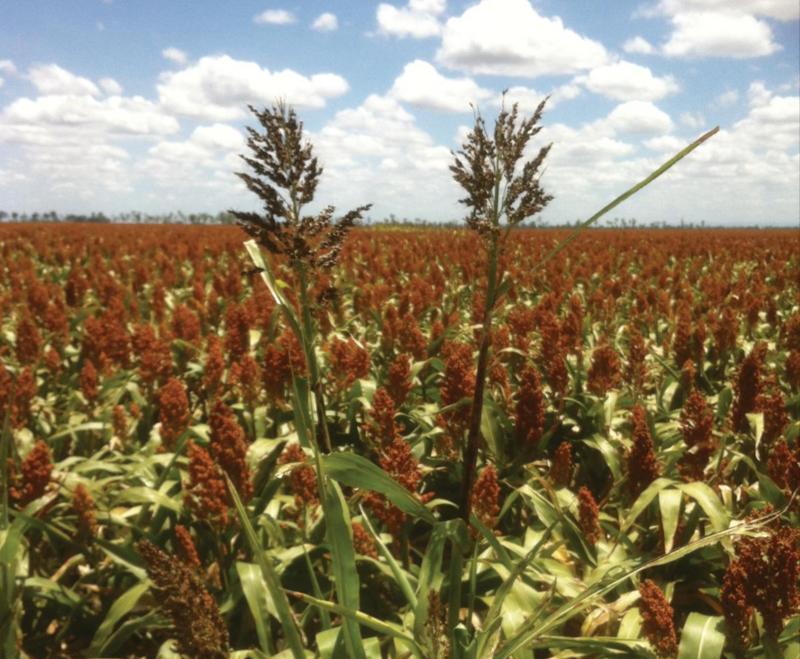LIVERPOOL Plains farmers Bernie and Kevin Perkins are all too familiar with shattercane infestation. In the spring of 2010, the brothers planted MR43 Elite sorghum seeds on their family property in North West NSW.
“Kevin and I had sorghum farming down to a fine art,” says Bernie. “In this part of the world, you can grow sorghum again and again on rotation and it’s extremely profitable to do so. But, 12 months after planting, we started to see a few strangers in that crop.”
By the summer of 2011-12, the “strangers” had become large shattercane plants that were growing outside the rows of sorghum and threatening to take over the 160-hectare crop.
“There had been a similar episode here on the plains about 20 years ago,” Bernie says.
“Those particular seeds had come from a different company, but the farmers involved in that infestation are still fighting shattercane on their properties today. You can’t just eradicate it.”
“Because it’s a similar type of grass to the actual sorghum plant itself, it’s very difficult to continue to grow sorghum when shattercane is here. It looks almost exactly like the sorghum plant but, in its initial years, it gets much higher. It doesn’t mature like sorghum does and you can’t harvest it.”
But Bernie says the real problem is when the seed pod shatters, scattering thousands of seeds. “It remains on the ground and continues to infest like any other weed,” he says. After several years of trying to eradicate it, the amount of shattercane on their farm prevents Bernie and Kevin from their preferred rotation of sorghum on sorghum. They now grow less profitable crops, such as chickpeas, wheat and barley.
“We hadn’t grown wheat for several years because we were making more money from the sorghum, but now we’ve had to totally change the way we manage the farm,” says Bernie. “We are certainly not making the money from these other crops that we did when we were growing sorghum on a continuous rotation.”
Along with Bernie and Kevin, nearly 50 farmers have taken steps to join a class action against one of the country’s leading grain seed companies. The farmers say they purchased and planted MR43 Elite sorghum seeds from Advanta Seeds, previously known as Pacific Seeds, between 2010 and 2014. The company is defending the claim.
Creevey Russell Lawyers’ principal Dan Creevey, who is representing the growers, says he suspects other farmers may be affected. The farmers are claiming for damages as a result of alleged shattercane infestations on their properties and the ongoing impact it has had on costs and yield over a number of years.
“We will call upon forensic accountants to give evidence as to the quantifications of damages suffered by the farmers, as well as expert agronomists to inform the court of the challenges facing the farmers subjected to shattercane infestations,” he says. One of the lead plaintiffs is claiming more than $2 million, and another $1.3 million. The class action came before the Supreme Court of Queensland in Brisbane on 18 April. Justice Debra Mullins heard arguments from both sides and allowed a second lead plaintiff to join the class action.
READ: The Red Lea investigation featuring 28 NSW chicken farmers owed millions and how the Association is helping retrieve their dollars.
Managing director of Advanta Seeds Nick Gardner declined to comment as the matter is now before the courts, except to say that the company strongly denies the claim and will “vigorously” defend the court case. The matter is expected to be listed for trial in early 2019.
“We are certainly not making the money from these other crops that we did when we were growing sorghum on a continuous rotation.” Bernie Perkins, Liverpool Plains - sorghum farmer

WHAT IS SHATTERCANE?
SHATTERCANE is an annual grass descended from wild and cultivated sorghum varieties. It is largely indistinguishable from commercial sorghum until it flowers. Its upright flowering branches, know as panicles, can each produce about 2,000 seeds (slightly smaller than sorghum seeds). Shattercane competes with crop plants and significantly reduces both quality and yield. Once on a farm, it spreads aggressively and is difficult and expensive to get rid of.